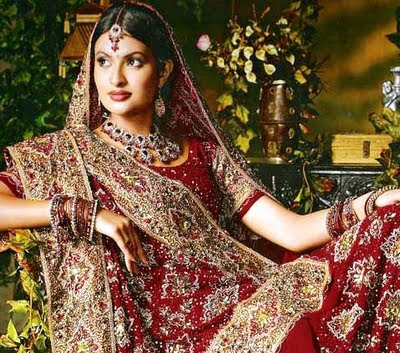Iindian wedding outfits Biogarphy
Source(google.com.pk)Wedding dresses have traditionally been based on the popular styles of the day. For example, in the 1920s, wedding dresses were typically short in the front with a longer train in the back and were worn with cloche-style wedding veils. This tendency to follow current fashions continued until the late 1940s, when it became popular to revert to long, full-skirted designs reminiscent of the Victorian era. Although there has always been a style that dominates the bridal market for a time, and then shifts with the changes in fashion, a growing number of modern brides are not choosing to follow these trends. This is due in large part to non-traditional and non-first-time weddings, and women who are marrying later in life.
Today, Western wedding dresses are usually white[1], though "wedding white" includes shades such as eggshell, ecru and ivory. […]
Mary, Queen of Scots, wore a white wedding gown in 1559 when she married her first husband, Francis Dauphin of France because it was her favorite color, although white was then the color of mourning for French Queens. The first documented instance of a princess who wore a white wedding gown for a royal wedding ceremony is that of Philippa of England, who wore a tunic with a cloak in white silk bordered with grey squirrel and ermine in 1406.[3]
White did not become a popular option until 1840, after the marriage of Queen Victoria to Albert of Saxe-Coburg. Victoria wore a white gown for the event to incorporate some lace she prized. The official wedding portrait photograph was widely published, and many other brides opted for white in accordance with the Queen's choice.[4]
The tradition continues today in the form of a white wedding, though prior to the Victorian era, a bride was married in any color, black being especially popular in Scandinavia.[5] Later, many people assumed that the color white was intended to symbolize virginity, though this was not the original intention. (It was the color blue that was connected to purity.) The white gown is in fact a symbolic Christening gown. It is a variation of the white surplice worn in the Western Catholic tradition by members of the clergy, church choirs and servers and the gowns worn by girls celebrating their first communion and at their confirmation and also by women making religious vows. Jews have gone to great lengths [6] to follow[7] these Western (Judeo-Christian) customs, whilst adhering to the laws of Tzniut. Today, the white dress is understood merely as the most traditional and popular choice for weddings.
NATIVE AMERICAN CULTURE
The indigenous peoples of the Americas have varying traditions related to weddings and thus wedding dresses. A Hopi bride traditionally would have her garments woven by the groom and any men in the village who wished to participate. The garments consisted of a large belt, two all-white wedding robes, a white wedding robe with red stripes at top and bottom, white buckskin leggings and moccasins, a string for tying the hair, and a reed mat in which to wrap the outfit. This outfit also would serve as a shroud, since these garments would be necessary for the trip through the underworld.
A Pueblo bride wore a cotton garment tied above the right shoulder, secured with a belt around the waist.
In the traditions of the Delaware, a bride would wear a knee-length skirt of deerskin and a band of wampum beads around her forehead. Except for fine beads or shell necklaces, the body would be bare from the waist up. If it were a winter wedding, she would wear deerskin leggings and moccasins and a robe of turkey feathers. Her face would be painted with white, red and yellow clay.
The tribes of Northern California (which include the Klamath, the Modoc and the Yurok) had a traditional bridal dress woven in symbolic colors: white for the east, blue for the south, yellow (orange) for the west; and black for the north. Turquoise and silver jewelry were worn by both the bride and the groom in addition to a silver concho belt. Jewelry was considered a shield against evils including hunger, poverty and bad luck.
Indian wedding outfits Wallpaper Photos Pictures Pics Images 2013

Indian wedding outfits Wallpaper Photos Pictures Pics Images 2013

Indian wedding outfits Wallpaper Photos Pictures Pics Images 2013
.jpg)
Indian wedding outfits Wallpaper Photos Pictures Pics Images 2013

Indian wedding outfits Wallpaper Photos Pictures Pics Images 2013

Indian wedding outfits Wallpaper Photos Pictures Pics Images 2013

Indian wedding outfits Wallpaper Photos Pictures Pics Images 2013

Indian wedding outfits Wallpaper Photos Pictures Pics Images 2013

Indian wedding outfits Wallpaper Photos Pictures Pics Images 2013

Indian wedding outfits Wallpaper Photos Pictures Pics Images 2013

Indian wedding outfits Wallpaper Photos Pictures Pics Images 2013
No comments:
Post a Comment